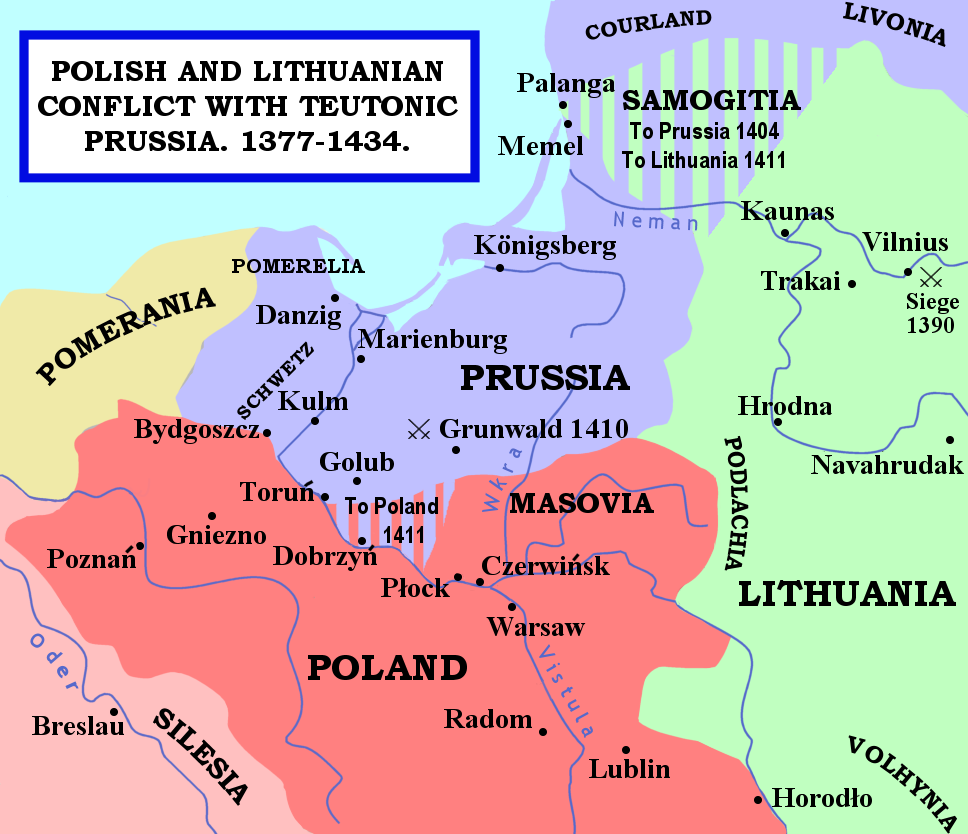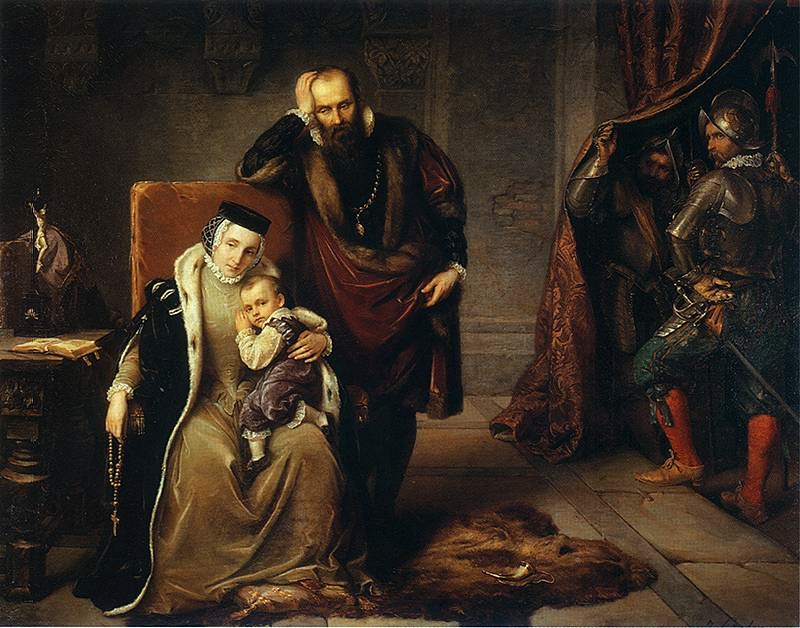|
Artus Court, Toruń
The Artus Court is a building located in Toruń, Poland. Built in 1889–1891, it houses a local government institution, the Cultural Centre, established in 1995. It is located in the Old Town complex, at Rynek Staromiejski 6. History The building takes up the place of three medieval parcels. The first Artus Manor, which was actually called "The Public House/Meeting House" or "The Club House" (the name Artus Manor emerged only at the beginning of the 17th century) was built in the years 1385–1386. In 1466 the Second Peace of Thorn was signed here. The building was later reconstructed and renovated, especially in the 17th century, when a rich painting decoration of the facade was made, on which friezes with images of kings from Władysław Jagiełło to Sigismund III Vasa were placed, known from a series of drawings created in the years 1738–1745 showing views of Toruń and the surrounding area prepared by Steiner. The ground floor room was also rebuilt, where, among other thin ... [...More Info...] [...Related Items...] OR: [Wikipedia] [Google] [Baidu] |
Toruń
Toruń is a city on the Vistula River in north-central Poland and a World Heritage Sites of Poland, UNESCO World Heritage Site. Its population was 196,935 as of December 2021. Previously, it was the capital of the Toruń Voivodeship (1975–1998) and the Pomeranian Voivodeship (1919–1939), Pomeranian Voivodeship (1921–1945). Since 1999, Toruń has been a seat of the local government of the Kuyavian-Pomeranian Voivodeship and is one of its two capitals, together with Bydgoszcz. The cities and neighboring counties form the Bydgoszcz–Toruń twin city metropolitan area. Toruń is one of the oldest cities in Poland; it was first settled in the 8th century and in 1233 was expanded by the Teutonic Knights. For centuries it was home to people of diverse backgrounds and religions. From 1264 until 1411, Toruń was part of the Hanseatic League and by the 17th century a leading trading point, which greatly affected the city's architecture, ranging from Brick Gothic to Mannerism, Mann ... [...More Info...] [...Related Items...] OR: [Wikipedia] [Google] [Baidu] |
Second Peace Of Thorn (1466)
The Peace of Thorn or Toruń of 1466, also known as the Second Peace of Thorn or Toruń (; ), was a peace treaty signed in the Hanseatic city of Thorn (Toruń) on 19 October 1466 between the Polish king Casimir IV Jagiellon and the Teutonic Knights, which ended the Thirteen Years' War, the longest of the Polish–Teutonic Wars. The treaty was signed in the Artus Court, and afterward a mass was held in the Gothic Franciscan Church of the Assumption of the Blessed Virgin Mary to celebrate the peace treaty. Background The treaty concluded the Thirteen Years' War which had begun in February 1454 with the revolt of the Prussian Confederation, led by the cities of Danzig (Gdańsk), Elbing (Elbląg), Kulm (Chełmno) and Toruń, and the Prussian gentry against the rule of the Teutonic Knights in the Monastic State, in order to join the Kingdom of Poland. Both sides agreed to seek confirmation from Pope Paul II and Holy Roman Emperor Frederick III, but the Polish side stre ... [...More Info...] [...Related Items...] OR: [Wikipedia] [Google] [Baidu] |
Władysław II Jagiełło
Jogaila (; 1 June 1434), later Władysław II Jagiełło (),Other names include (; ) (see also Names and titles of Władysław II Jagiełło) was Grand Duke of Lithuania beginning in 1377 and starting in 1386, becoming King of Poland as well. As Grand Duke, he ruled Lithuania from 1377 to 1381 and from 1382 to 1401, at which time he became the Supreme Duke of Lithuania in exchange for naming his cousin Vytautas as the new Grand Duke. Władysław II initially served as King of Poland alongside his wife Jadwiga of Poland, Jadwiga until her death in 1399, and then the sole ruler until his own death in 1434. Raised a Lithuanian polytheist, he converted to Catholicism in 1386 and baptized as Ladislaus () in Kraków, married the young Queen Jadwiga, and was crowned King of Poland as Władysław II Jagiełło. In 1387, he Christianization of Lithuania, converted Lithuania to Catholicism. His reign in Poland started in 1399, upon the death of Queen Jadwiga, lasted a further thirty-fiv ... [...More Info...] [...Related Items...] OR: [Wikipedia] [Google] [Baidu] |
Sigismund III Vasa
Sigismund III Vasa (, ; 20 June 1566 – 30 April 1632 N.S.) was King of Poland and Grand Duke of Lithuania from 1587 to 1632 and, as Sigismund, King of Sweden from 1592 to 1599. He was the first Polish sovereign from the House of Vasa. Religiously zealous, he imposed Catholicism across the vast realm, and his crusades against neighbouring states marked Poland's largest territorial expansion. As an enlightened despot, he presided over an era of prosperity and achievement, further distinguished by the transfer of the country's capital from Kraków to Warsaw. Sigismund was the son of King John III of Sweden and his first wife, Catherine Jagiellon, daughter of King Sigismund I of Poland. Elected monarch of the Polish–Lithuanian Commonwealth in 1587, he sought to unify Poland and Sweden under one Catholic kingdom, and when he succeeded his deceased father in 1592 the Polish–Swedish union was created. Opposition in Protestant Sweden caused a war against Sigismund headed ... [...More Info...] [...Related Items...] OR: [Wikipedia] [Google] [Baidu] |
Marble
Marble is a metamorphic rock consisting of carbonate minerals (most commonly calcite (CaCO3) or Dolomite (mineral), dolomite (CaMg(CO3)2) that have recrystallized under the influence of heat and pressure. It has a crystalline texture, and is typically not Foliation (geology), foliated (Layered intrusion, layered), although there are exceptions. In geology, the term ''marble'' refers to metamorphosed limestone, but its use in stonemasonry more broadly encompasses unmetamorphosed limestone. The extraction of marble is performed by quarrying. Marble production is dominated by four countries: China, Italy, India and Spain, which account for almost half of world production of marble and decorative stone. Because of its high hardness and strong wear resistance, and because it will not be deformed by temperature, marble is often used in Marble sculpture, sculpture and construction. Etymology The word "marble" derives from the Ancient Greek (), from (), "crystalline rock, shin ... [...More Info...] [...Related Items...] OR: [Wikipedia] [Google] [Baidu] |
Prussia
Prussia (; ; Old Prussian: ''Prūsija'') was a Germans, German state centred on the North European Plain that originated from the 1525 secularization of the Prussia (region), Prussian part of the State of the Teutonic Order. For centuries, the House of Hohenzollern ruled Prussia, expanding its size with the Prussian Army. Prussia, with its capital at Königsberg and then, when it became the Kingdom of Prussia in 1701, History of Berlin, Berlin, decisively shaped the history of Germany. Prussia formed the German Empire when it united the German states in 1871. It was ''de facto'' dissolved by 1932 Prussian coup d'état, an emergency decree transferring powers of the Prussian government to German Chancellor Franz von Papen in 1932 and ''de jure'' by Abolition of Prussia, an Allied decree in 1947. The name ''Prussia'' derives from the Old Prussians who were conquered by the Teutonic Knightsan organized Catholic medieval Military order (religious society), military order of Pru ... [...More Info...] [...Related Items...] OR: [Wikipedia] [Google] [Baidu] |
Józef Haller
Józef Haller (''de Hallenburg''; 13 August 1873 – 4 June 1960) was a Polish lieutenant general and legionary in the Polish Legions during the First World War. He was a harcmistrz (the highest Scouting instructor rank in Poland), the president of the Polish Scouting and Guiding Association (ZHP), and a political and social activist. He was also the cousin of Stanisław Haller. Haller was born in Jurczyce. He studied at Vienna's Technical Military Academy and subsequently (1895–1906) served with the Austrian Army, resigning after reaching the rank of captain. He supported the paramilitary pro-independence Polish organization Sokół. In 1916, during the First World War, he became commander of the Second Brigade of the Polish Legion, in particular the units which fought against Russia on the Eastern Front. In 1918, in the aftermath of the " Charge at Rarańcza", as commander of the 2nd Polish Auxiliary Corps with the Austrian Army, Haller broke through the Aust ... [...More Info...] [...Related Items...] OR: [Wikipedia] [Google] [Baidu] |
Stanisław Wojciechowski
Stanisław Wojciechowski (; 15 March 1869 – 9 April 1953) was a Polish people, Polish politician and scholar who served as President of Poland between 1922 and 1926, during the Second Polish Republic. He was elected president in 1922, following the assassination of his predecessor Gabriel Narutowicz. During his presidency, Wojciechowski and his erstwhile friend Józef Piłsudski disagreed on the political direction of the nation. In 1926, Piłsudski staged a May Coup (Poland), military coup, which resulted in Wojciechowski resigning from office. Early life Stanisław Wojciechowski was born on 15 March 1869 in Kalisz into a Polish noble family with strong ties to the intelligentsia. He was one of seven children of Second Lieutenant Feliks Wojciechowski (1825-1881), a caretaker of a prison in Kalisz who participated during the January Uprising, and his wife Florentyna Vorhoff. He was raised in a spirit of patriotism and devotion to his homeland. In 1888, he graduated in the Ka ... [...More Info...] [...Related Items...] OR: [Wikipedia] [Google] [Baidu] |
Ignacy Mościcki
Ignacy Mościcki (; 1 December 1867 – 2 October 1946) was a Polish chemist and politician who was the country's president from 1926 to 1939. He was the longest serving president in Polish history. Mościcki was the President of Poland when Germany invaded the country on and started World War II. Early life and career Mościcki was born on 1 December 1867 in Mierzanowo, a small village near Ciechanów, Congress Poland. After completing school in Warsaw, he studied chemistry at the Riga Polytechnicum, where he joined the Polish underground leftist organization, ''Proletariat''. Upon graduating, he returned to Warsaw where he married Michalina Czyżewska but was soon threatened by the Tsarist secret police with life imprisonment in Siberia and was forced to emigrate with his family in 1892 to London. In 1896, he was offered an assistantship at the University of Fribourg in Switzerland. There, he patented a method for cheap industrial production of nitric acid. In 1912, M ... [...More Info...] [...Related Items...] OR: [Wikipedia] [Google] [Baidu] |




